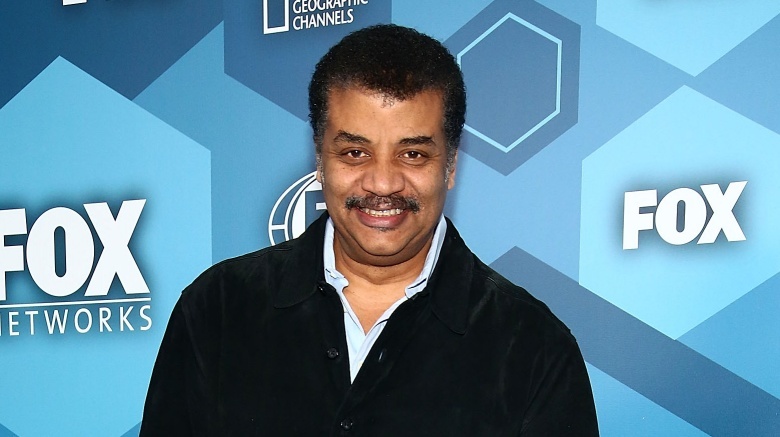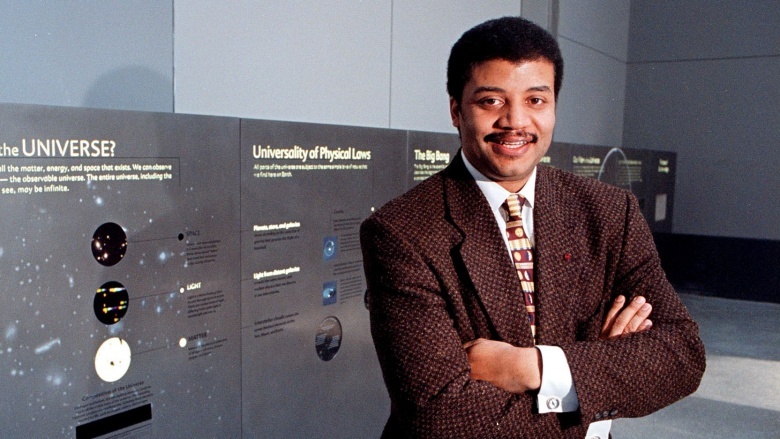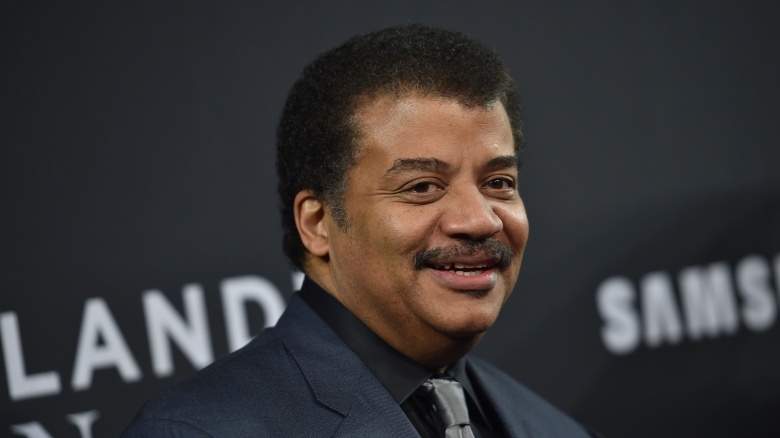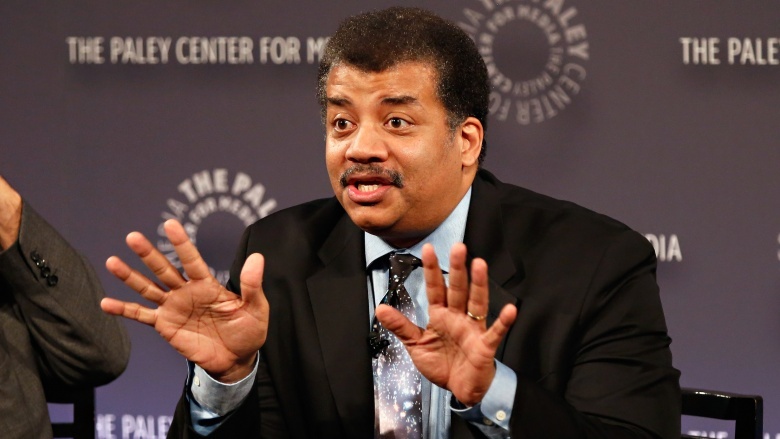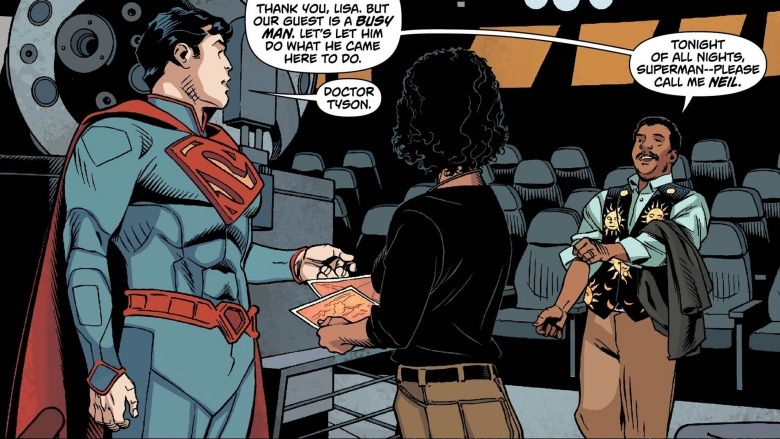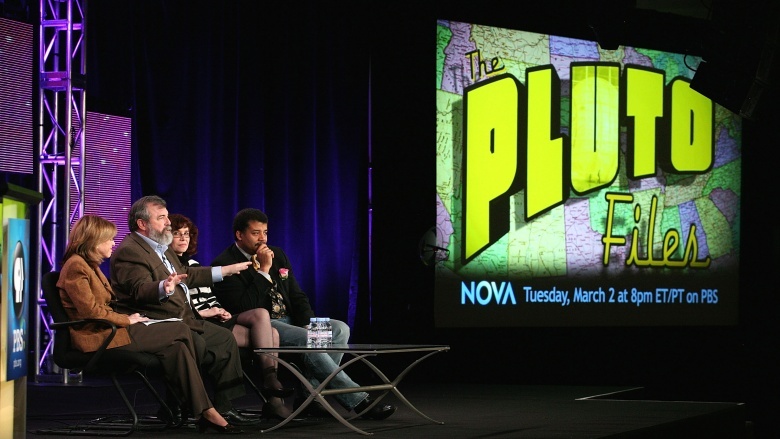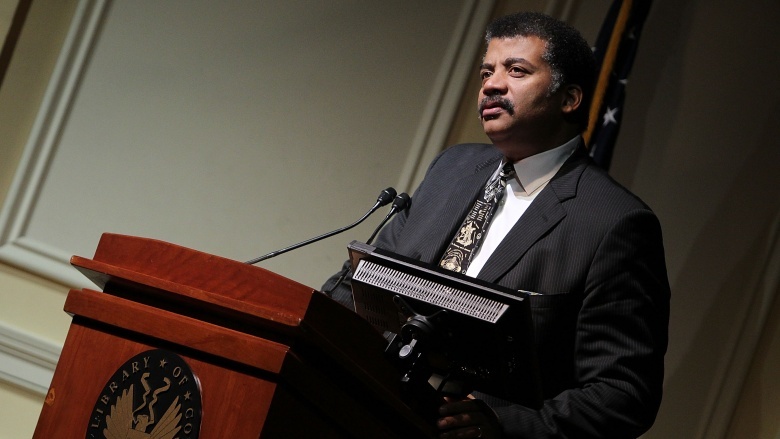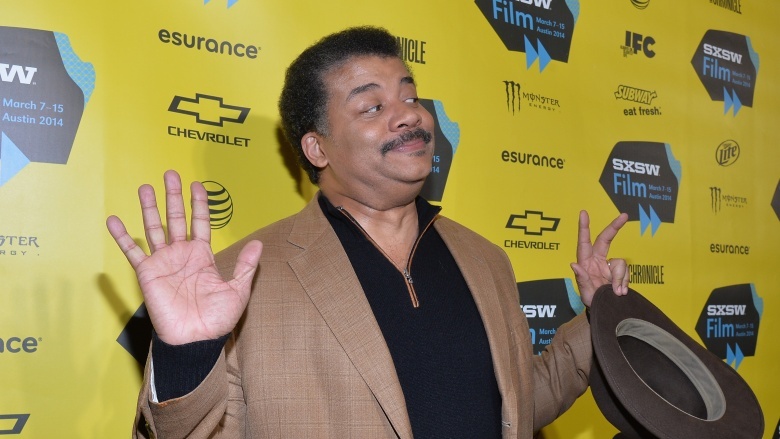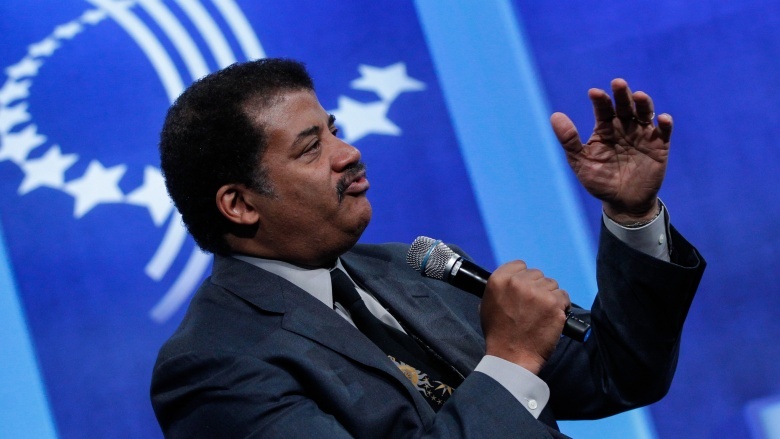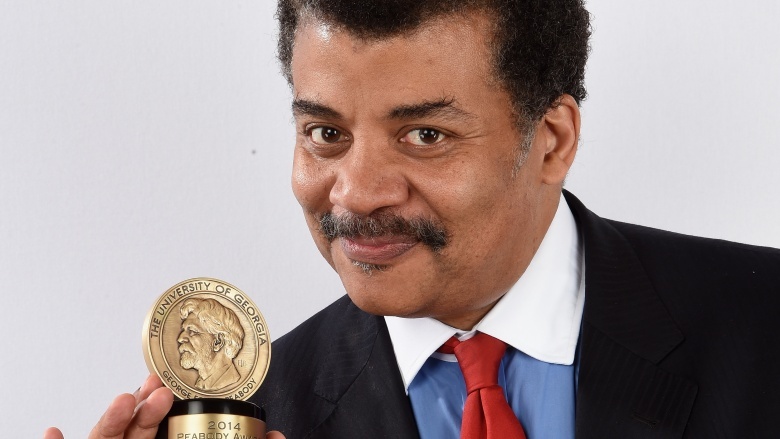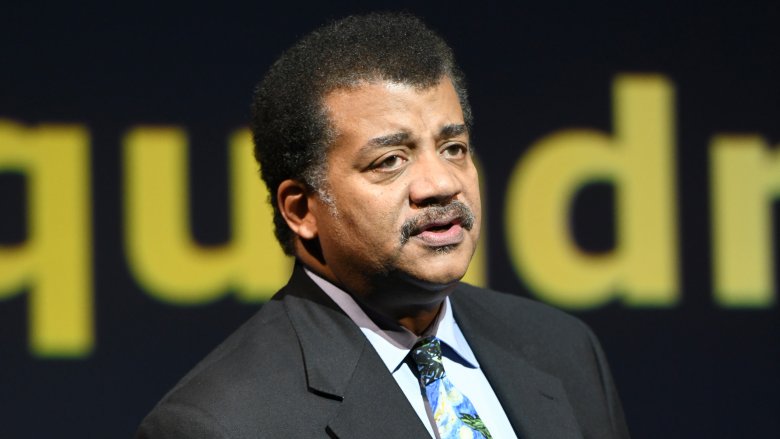The Untold Truth Of Neil deGrasse Tyson
From serious astrophysicist and researcher, to television star, to public science speaker and educator, Dr. Neil deGrasse Tyson has led an amazing life. His stellar career started as an astronomy-obsessed youth in the Bronx and led him all the way to becoming the lead astronomer at the Hayden Planetarium and the host of Cosmos: A Spacetime Odyssey, which has won several Emmys and a Peabody Award. Maybe you know some of Tyson's life story or maybe you only know him as the popular "Internet Badass" meme. We're going to take a look at the little-known facts behind the man who reintroduced a generation to the wonder of the stars.
The Hayden Planetarium kickstarted his career
When Tyson was just nine years old, he took a fateful trip to the Hayden Planetarium at the Museum of Natural History in New York City. The experience would prove transformative to Tyson, who later recalled in an interview with Stephen Colbert that "so strong was that imprint [of the night sky] that I'm certain that I had no choice in the matter, that in fact, the universe called me." So began Tyson's love affair with the stars. He would later attend classes in astronomy at the Hayden Planetarium, and he credits then-director Dr. Mark Chartrand III as his first "intellectual role-model," saying he modeled his humor-filled and enthusiastic teaching style after Chartrand's. Perhaps it was fate. Tyson would later go on to become the director of the Hayden Planetarium himself in 1996—a post he has now held for more than 20 years.
He was a star wrestler and almost an exotic dancer
During his time pursuing an undergraduate degree in physics at Harvard, Tyson was also active in sports. He was a member of the crew (rowing) team in his freshman year but then switched to wrestling—a sport he was undefeated in during his high school years, when he served as his high school team's captain. In his youth, he once ran a 4:25 mile, and even invented his own signature wrestling move—the "Double Tidal Lock."
After lettering in wrestling during his senior year at Harvard, Tyson went on to the University of Texas for his graduate studies in astronomy. While at UT, Tyson became active in wrestling again as well as the school's dance program, competing with the college team in styles including ballet, jazz, Afro-Caribbean, and Latin Ballroom. In 1985, he even won a gold medal with the team at a national tournament in the Latin Ballroom style. Tyson even considered going into exotic, Chippendale-style dancing for extra cash after a few of his fellow dancers at UT began doing so. "They invited me because I needed more money, I was broke. So I went just to observe it [to see] if it was something I could do, and they came out with jockstraps having been soaked in lighter fluid—asbestos jockstraps, ignited—coming out dancing to Jerry Lee Lewis' 'Great Balls of Fire.' I said, 'Nope. Not for me.' I'm embarrassed to say that it wasn't until that moment when I said to myself, 'Maybe I should be a math tutor.' I don't know why I didn't think of that first."
He flunked out of his doctorate studies at UT
After completing his master's thesis at the University of Texas in Austin, Tyson began to pursue a doctorate in the same field—astronomy. But things didn't go quite as planned. Tyson faced racial discrimination on the campus, being stopped and searched by campus police on seven different occasions as he entered the school's physics building. He also found little support from his dissertation advisers due to his lack of progress in the lab—and his aforementioned deep involvement in the school's sports and extracurricular programs.
Eventually, his dissertation advisers dissolved their committee—essentially flunking Tyson out of their doctorate program. As UT professor Craig Wheeler recalls, "Research was not his strength. He was never going to solve any major scientific problems. But I knew he was going to do something big, because he had charisma. He's warm and funny, but he also has serious backbone, ambition, confidence—and that's taken him far." Tyson himself agrees with the assessment, saying, "I don't hold a grudge, and I don't blame the department for kicking me out. I might have done the same thing in their position." However, he has also made it clear that he still has some raw feelings about the experience at UT: "When I look at my life, the tracks of my success take a detour around Texas," he says. "It's the only place where I didn't succeed, and I'm still figuring out what that means."
He helped Superman see Krypton
That's right, Neil deGrasse Tyson once gave an assist to the Man of Steel. In Action Comics 14, Tyson and his Hayden Planetarium play a pivotal role in the plot. DC Comics approached Tyson and asked for permission to use the planetarium and Tyson's likeness in the comic, in which Superman visits the Hayden in an attempt to witness the destruction of his home planet. Tyson, who appears on the pages of the comic in one of his trademark star-spangled vests, agreed to the idea and helped the comic developers out by picking a real star—LHS 2520—as the doomed location of Krypton's solar system. LHS 2520 was an apt choice, as the red dwarf planet matches characteristics of the fictional "Rao" from Superman canon, and it belongs to the constellation Corvus ("The Crow"), which is the fictional mascot of Smallville's high school team. In the comic, Tyson and astronomers around the world help Superman watch the demise of Krypton by harnessing the power of space telescopes worldwide to catch a glimpse of the planet. If Superman is coming to you for help, you know you're doing something right.
He helped "demote" Pluto
For years, children across the country learned the planets of our solar system with the mnemonic: "My very eager mother just served us nine pizzas." No longer. After the demotion of Pluto to the status of "dwarf planet" in 2006 by the International Astronomical Union, the phrase has been revised to "My very eager mother just served us nachos." Pizzas and nachos aside, Tyson had a hand in Pluto's eventual embarrassment. While not solely responsible for the movement that led to the demotion of Pluto—a movement led by astronomer Mike Brown—Tyson admits that he did help drive the "getaway car." He refused to refer to Pluto in the Hayden Planetarium's display as the ninth planet. During an interview with NPR, Tyson explained that Pluto was just too different from the rest of the solar system's orbital bodies to be classified the same way. "More than half of its volume is ice. No other planet has that ... its orbit is elongated so severely that it crosses the orbit of Neptune, [and] there are six moons in the solar system that are bigger than Pluto. So really, Pluto was never the ninth planet; it was the first of a new class of objects that we didn't really discover the rest of until the early 1990s."
Some people have called him out for bad behavior
While many people have nothing but good things to say about Neil deGrasse Tyson, a few stories have emerged alleging that he's not the easiest guy to work with. During the StarTalk series Tyson participated in (along with some other notable scientists), he received some flak from viewers for his habit of interrupting and talking over his fellow presenters. In one segment in particular, Tyson rails against "soft sciences" and bashes his co-presenter, biologist Richard Dawkins. In another incident during a Q&A session at the American Museum of Natural History, Tyson calls out an audience member for starting her question with the word, "Um."
In perhaps the most interesting anecdote about Tyson's behavior, a Redditor claimed that his college club once spent around $85,000 to bring the astrophysicist to their school for a lecture. The Redditor alleged that during his day at the college, he insulted students in the club that he felt were pursuing "worthless" degrees, and his lecture consisted of primarily "fart jokes and fan service; teasing the upcoming TV series he was in and not much else." In a story from another Redditor who claimed to be part of the same club, it was also alleged that in the middle of said lecture—which had cost them thousands of dollars and taken a full year to organize—Tyson got out his iPhone and "spent the next fifteen minutes trying to come up with the perfect wording for [a joke] to post it to his Twitter."
He disturbed the balance of the Force
Well, maybe that's a bit of an exaggeration—but Tyson did stir up quite a few Star Wars fans after he made some Twitter comments criticizing the "science" in the sci-fi space saga's new installment, The Force Awakens. In the past, Tyson had angered Star Wars fans when he claimed that the starship Enterprise from Star Trek would "wipe its a**" with the Millennium Falcon. Tyson doubled down on the Star Wars criticism in a series of tweets a week after The Force Awakens was released when he called out several inaccuracies that he felt the Star Wars development team got wrong. His criticisms included the sound that TIE fighters make in space versus the sound they make in an atmosphere, the apparently slower aging displayed by Wookiees when compared to humans, and the implausibility of Starkiller Base. Ignoring the fact that Star Wars is a sci-fi franchise based on fantasy, not our current state of physics, Tyson definitely riled up some fans of the series with these comments.
Perhaps most controversial among his tweets was when Tyson claimed that BB-8, being a spherical metal object, would "skid uncontrollably" in a sandy environment like that found on Jakku. The official Star Wars Twitter account replied to correct Tyson with a production video that showed BB-8 was a real robot (including a remote-controlled model) produced by their team and which was used during their desert filming. Of course, the debate didn't end there. Fans on YouTube have produced tests of their own using the Sphero BB-8 toy version of the robot, with some tests showing success on sand and others failing miserably. Obviously, the debate will continue—unless Disney releases clear footage of their full-scale BB-8 model moving under its own power in the desert—but Tyson will likely stay out of it from now on. The astrophysicist told Conan O'Brien in an interview that fans of the sci-fi series are "prickly people," and that some of them have "lost their minds" over his criticisms of the saga. "I wonder if I should continue to tweet about movies," he pondered. "People seem to be deeply upset by it."
The fault in our stars
The Twitter spat with Star Wars fans wasn't the first time Tyson had called out a movie for something most would consider nitpicking. After James Cameron's blockbuster Titanic came out in 1997, Tyson wrote the director to complain about the position of the stars in the sky when Rose gazes up at them during the film's climactic scene. "There is only one sky she should have been looking at ... and it was the wrong sky! Worse than that ... the left half of the sky was a mirror reflection of the right half of the sky. It was not only wrong, it was lazy." Cameron gave no response to the letter, but Tyson reported the two later met at an event and the director told him, "Last I checked, Titanic had grossed $1.3 billion worldwide. Think how much more it would have grossed if I'd gotten the sky correct." Despite his sarcastic reply, Cameron reportedly did take Tyson's complaint into consideration, and his post-production team contacted Tyson in order to find out the correct positioning for the stars—which were later aligned properly in the 2012 re-release of the movie.
He's one of the most decorated scientists in his field
Even though Tyson has not done much serious research in some time—his last published paper was in 2008—the astrophysicist has done much to further science education among the general public, and he's been recognized many times for those efforts. Besides the awards he won with Cosmos, Tyson's laundry list of awards and honors includes a Distinguished Public Service Medal from NASA, an Isaac Asimov Award, a Public Welfare Medal from the National Academy of Sciences, an asteroid named for him (13123 Tyson), Time magazine's title of "Sexiest Astrophysicist Alive," and a massive 19 honorary doctorate degrees.
He's experienced the wrath of social media
Tyson has done more than many when it comes to using social media to spread scientific knowledge, but instant communication platforms always carry the risk of incorrect or insensitive statements and the subsequent backlash — and no matter how smart a person might be, we're all susceptible to mistakes. Tyson was reminded of this hard truth firsthand in August of 2019, when he compared the death toll from a spate of recent mass shootings to the number of people lost to a variety of other accidents or ailments over any random 48-hour span. "Often," he noted, "our emotions respond more to spectacle than to data."
Tyson's tweet sparked a social media outcry that prompted a quick apology — also, naturally, shared via social media. "My intent was to offer objectively true information that might help shape conversations and reactions to preventable ways we die," he wrote. "I apologize for not knowing in advance what effect my Tweet could have on you. I am therefore thankful for the candor and depth of critical reactions shared in my Twitter feed."
